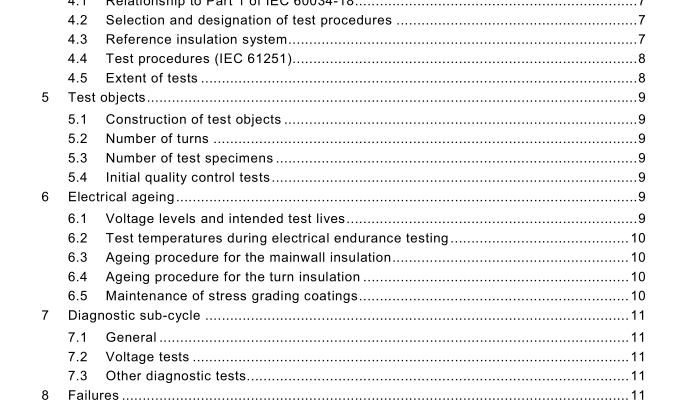IEC 60034-18-32:2010 pdf download – Rotating electrical machines – Part 18-32: Functional evaluation of insulation systems – Test procedures for form-wound windings – Evaluation by electrical endurance
4.4 Test procedures (IEC 61251)
4.4.1 General Electrical ageing tests are usually performed at fixed voltage levels until failure. From such tests, characteristic times to failure at each voltage level are obtained. The results for both the candidate system and the reference system should be reported on a graph, as shown by the example in Figure 1 , and compared. There is no proven physical basis for extrapolation of this characteristic to the service voltage level U N / 3 , where U N is the r.m.s. rated phase to phase voltage. Statistical evaluation of the results of testing should be performed according to IEC 62539.
4.4.2 Electrical ageing of the mainwall insulation In service, electrical ageing of the mainwall insulation is primarily caused by continuous elec- trical stress at power frequency. In addition, the insulation is required to withstand transient over-voltages arising from switching surges or inverter supply. The ability of the mainwall insulation to withstand transient over-voltages from converter supplies may be demonstrated by the system’s performance using IEC 60034-1 8-42. This standard describes voltage ageing of the mainwall insulation, carried out at power frequency or at a frequency up to 1 0 times greater.
4.4.3 Electrical ageing of the turn insulation Electrical ageing of the turn insulation can arise due to the steady-state stress applied across the mainwall insulation. This could be particularly significant at the edges of the conductors where the electrical stress reaches a maximum. Where multiturn coils or bars are used, the power frequency voltage between turns is sufficiently low that ageing due to this electric stress is not of major significance. However, steep-fronted surges on the winding caused by switching and other disturbances can generate sufficient stress between turns for ageing to take place. Since the waveforms and frequency of occurrence are variable and dependent upon circuit parameters, this International Standard recommends that, for comparison purposes, electrical ageing of the turn insulation be performed using IEC 60034-1 8-42.
4.5 Extent of tests
4.5.1 Full evaluation The extent of the electrical functional tests will depend upon the purpose of the evaluation. A full evaluation will be needed where there are substantial differences in the compositions of the reference and candidate systems.
4.5.2 Reduced evaluation There are situations when it will be sufficient to carry out reduced evaluation using the minimum number of test specimens and the middle voltage level from the range of reference tests. Comparison of a candidate insulation system to a reference system, where there are no intended or only minor differences in composition or manufacturing procedures (so-called minor changes, see IEC 60034-1 8-1 ), may be carried out using only one voltage level but with the recommended minimum number of test specimens (see 5.3). Reduced evaluation is allowed only if the rated voltages are the same for both systems. An example of a minor change might be the sourcing of the same material from a different supplier or a change of pulping process. An example of a minor processing change might be the installation of a new controller or new pipework in a vacuum pressure impregnation (VPI) process. It should be emphasized that a minor change is one which is not expected to have a significant effect on the insulation system. It is the responsibility of the manufacturer to justify the use of the reduced qualification procedure
5 Test objects
5.1 Construction of test objects Test objects should preferably be complete bars or coils made to normal manufacturing standards. Alternatively, they may be constructed to represent the configuration of the finished winding component to be evaluated and be subjected to the full normal or intended manufacturing processes. When using separate coils or bars as models, creepage distances and any necessary voltage grading are to be appropriate to the stresses applied during testing. An electrode should extend the full slot length of the model and encircle the entire circumference of the coil cross-section.
